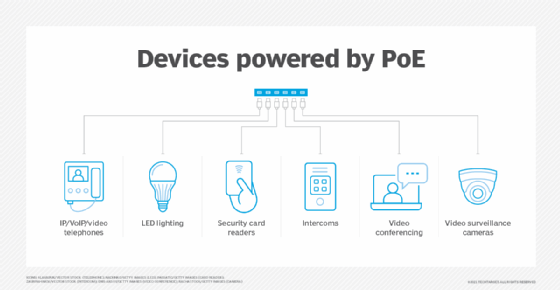Power over Ethernet (PoE)
What is Power over Ethernet?
Power over Ethernet (PoE) is a technology for implementing wired Ethernet local area networks (LANs) that enables the electrical current necessary for operating each device to be carried by Ethernet data cables instead of standard electrical power cords and wiring.
Used both in smart home applications and business premises, PoE uses cheaper Ethernet cabling, which can transport both power and data, instead of electrical wiring, which supplies power only and requires separate wiring for data. Because PoE transports both power and data over Ethernet cable, less wiring is necessary, and electrical wiring can remain intact.
The PoE standard was developed in 2003 to support devices like wireless access points (APs). Prior to that, individual vendors used various forms of proprietary PoE to provide PoE capabilities. Some of these proprietary PoE devices remain in use today. PoE installers must determine where these older, proprietary devices are located because they can prove to be troublesome or incompatible with the standard PoE devices that came later. Today's standard PoE devices make AP installations easier and more flexible, especially in ceilings, which can be difficult areas to wire for electrical power.
How does PoE work?
For PoE to work, the electrical current must go into an Ethernet data cable at the power supply end and come out at the device end. With Ethernet, the power current can be kept separate from the data signal so neither interferes with the other. Current enters the Ethernet cable via a component called an injector. If the device at the other end of the cable is PoE-compatible, it will function properly without modification. If it is not PoE-compatible, a component called a picker, or tap, must be installed to extract the current from the cable. This picked-off current is routed to the power jack.
What devices use PoE?
Equipment built to the 2003 PoE standard initially delivered enough power for most APs but could not provide enough power for other types of mounted technology, such as video surveillance cameras. Over the years, the Institute of Electrical and Electronics Engineers (IEEE) and several vendors have attempted to address the power issue, but interoperability problems have persisted.
POE supports the following devices that consume 30 watts (W) of power or less:
- Internet Protocol, voice over IP and video telephones;
- Worldwide Interoperability for Microwave Access, or WiMAX, and wireless AP devices or nodes;
- pan, tilt and zoom robotic cameras;
- remote computer terminals, computer monitors, laptops, thin client computers and large computer display screens;
- liquid crystal display screens and large TVs;
- door access systems and video signing displays; and
- network audio.

In 2018, IEEE released IEEE 802.3bt, a new PoE standard also known as high-power PoE or PoE+. It accommodates use of four-wire pairs with Cat5 or Cat6 cable, which supports individual devices that require as much as 90 to 100 W of power. Devices this standard supports include the following:
- light-emitting diode lighting
- security card readers
- high-performance wireless APs
- intercoms
- video conferencing
- video surveillance cameras
PoE benefits
The advantages of PoE include the following:
- Ease of installation. There are no worries about hooking into electrical system outlets.
- Cost savings. Ethernet can carry both power and data signals.
- Safety. PoE automatically stops power current flows if there is a service interruption.
- Data speed. PoE can now deliver data at 1 gigabit per second (Gbps) -- 10/100/1,000 megabits per second -- using Cat5 and Cat6 cables. The IEEE 802.3bz PoE standard delivers speeds of 2.5 Gbps to 5 Gbps over 100 meters (m).
- Security. POE devices attached to networks with high-level security enjoy the same security protection as other network assets.
PoE drawbacks
PoE is not a panacea. Concerns can include the following:
- Outages. A single PoE connection usually connects to multiple devices. If there is one failure in the stream of devices, all the devices go down.
- Power limits. Devices supported under the 2003 PoE standard are limited to 30 W. Devices requiring higher wattage must comply with PoE release IEEE 802.3bz.
- Higher switch costs. While PoE provides cost savings by combining power and data signals, PoE switches cost more than ordinary switches.
- Distance limits. PoE power transmission is limited to 100 m unless PoE extenders or other methods are used to supply power.
- Security. If network security is lacking, bad actors who want to penetrate PoE devices attached to these networks will have an easier time gaining access.
Learn which IEEE 802 wireless standards apply to technologies such as Ethernet and wireless.







